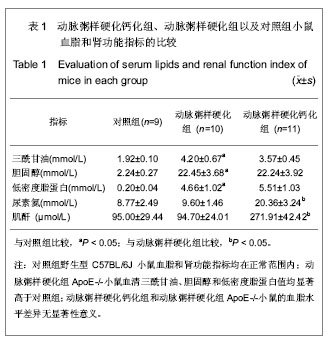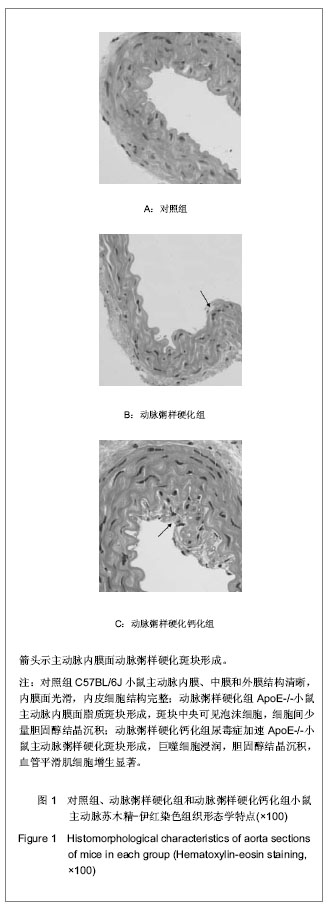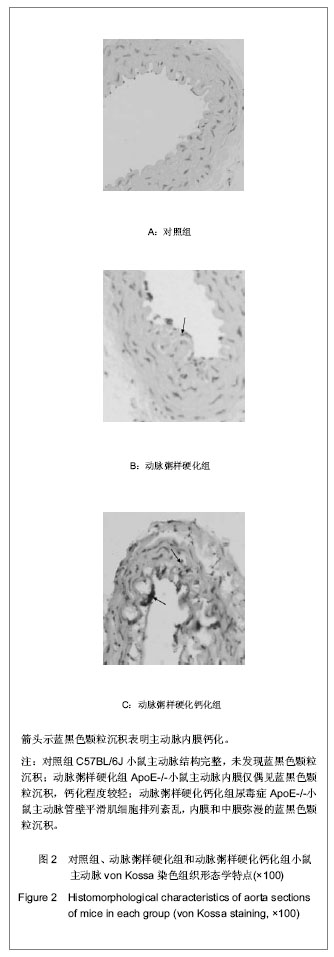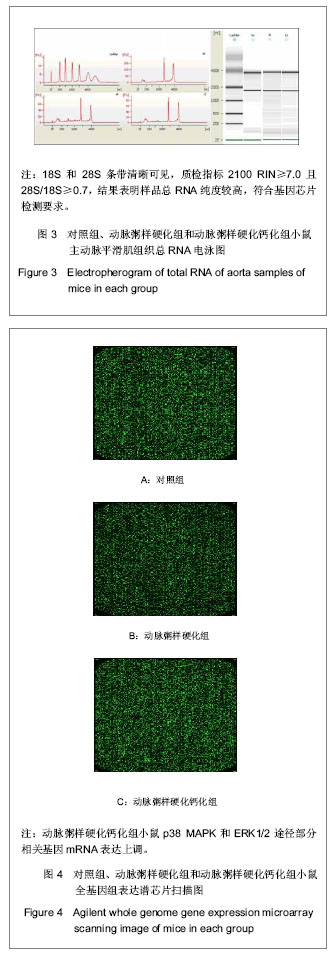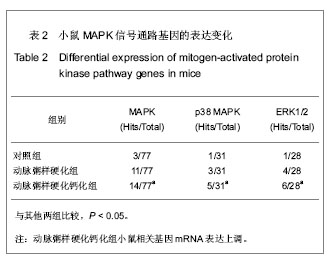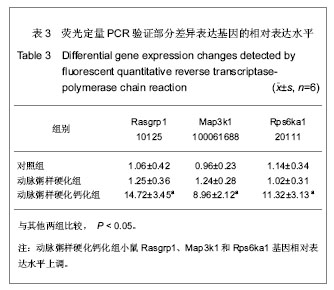| [1] Johnson RC, Leopold JA, Loscalzo J. Vascular calcification: pathobiological mechanisms and clinical implications. Circ Res. 2006;99(10):1044-1059. [2] Lee MJ, Shin DH, Kim SJ, et al. Progression of aortic arch calcification over 1 year is an independent predictor of mortality in incident peritoneal dialysis patients. PLos One. 2012;7(11):e48793. [3] Iyemere VP, Proudfoot D, Weissberg PL, et al.Vascular smooth muscle cell phenotypic plasticity and the regulation of vascular calcification. J Intern Med. 2006;260(3):192-210. [4] Zhu D, Mackenzie NC, Millán JL, et al. The appearance and modulation of osteocyte marker expression during calcification of vascular smooth muscle cells. PLos One. 2011;6(5):e19595.[5] Tanaka T, Sato H, Doi H, et al. Runx2 represses myocardin-mediated differentiation and facilitates osteogenic conversion of vascular smooth muscle cells. Mol Cell Biol. 2008;28(3):1147-1160.[6] Speer MY, Li X, Hiremath PG, et al. Runx2/Cbfa1, but not loss of myocardin, is required for smooth muscle cell lineage reprogramming toward osteochondrogenesis. J Cell Biochem. 2010;110(4):935-947. [7] Gagnon RF, Gallimore B. Characterization of a mouse model of chronic uremia. Urol Res. 1988;16(2):119-126.[8] Duan XH, Qi YF, Tang CS. Zhongguo Dongmai Yinghua Zazhi. 2008;16(2):153-157.段晓辉,齐永芬,唐朝枢. 血管钙化动物模型的研究进展[J]. 中国动脉硬化杂志,2008,16(2):153-157.[9] Cheng XZ,Huang B, Zhong H. Shengwu Jishu Tongxun. 2010; 21(1):112-115.程孝中,黄蓓,钟辉.动脉钙化发生机制研究进展[J].生物技术通讯, 2010,21(1):112-115.[10] Neven E, D'Haese PC. Vascular calcification in chronic renal failure: what have we learned from animal studies? Circ Res. 2011;108(2):249-264.[11] Moe SM, Chen NX. Pathophysiology of vascular calcification in chronic kidney disease. Circ Res. 2004;95(6):560-567. [12] You HZ, Ding F. Guoji Miniao Xitong Zazhi. 2007;27(2): 244-247.游怀舟,丁峰. 慢性肾脏病血管钙化的研究进展[J]. 国际泌尿系统杂志,2007,27(2): 244-247.[13] Yao Y, Bennett BJ, Wang X, et al. Inhibition of bone morphogenetic proteins protects against atherosclerosis and vascular calcification. Circ Res. 2010;107(4):485-494. [14] Boström KI, Jumabay M, Matveyenko A, et al. Activation of vascular bone morphogenetic protein signaling in diabetes mellitus. Circ Res. 2011;108(4):446-457. [15] Nakagami H, Osako MK, Morishita R. New concept of vascular calcification and metabolism. Curr Vasc Pharmacol. 2011;9(1):124-127. [16] Lai LQ, Yuan YS, Hao J, et al. 2010;32(10):1043-1050.赖林泉,袁运生,郜尽,等. MAPK信号通路基因在小鼠肝再生中的表达谱变化[J]. 遗传, 2010,32(10):1043-1050.[17] Miersalijiang•Yasen, Guo CJ, Fei QM, et al. Zhongguo Zuzhi Gongcheng Yanjiu yu Linchuang Kangfu. 2011;15(27): 4975-4978.米尔萨力江•亚森,郭常军,费琴明,等. 基因芯片分析成骨生长肽对OPG-/-小鼠骨髓间充质干细胞的作用[J]. 中国组织工程研究与临床康复,2011,15(27):4975-4978.[18] Mebratu Y, Tesfaigzi Y. How ERK1/2 activation controls cell proliferation and cell death: Is subcellular localization the answer? Cell Cycle. 2009;8(8):1168-1175. [19] Meloche S, Pouysségur J. The ERK1/2 mitogen-activated protein kinase pathway as a master regulator of the G1- to S-phase transition. Oncogene. 2007;26(22):3227-3239. [20] Oeztuerk-Winder F, Ventura JJ. The many faces of p38 mitogen-activated protein kinase in progenitor/stem cell differentiation. Biochem J. 2012;445(1):1-10.[21] del Barco Barrantes I, Nebreda AR. Roles of p38 MAPKs in invasion and metastasis. Biochem Soc Trans. 2012;40(1): 79-84. [22] Ding HT, Wang CG, Zhang TL, et al. Fibronectin enhances in vitro vascular calcification by promoting osteoblastic differentiation of vascular smooth muscle cells via ERK pathway. J Cell Biochem. 2006;99(5):1343-1352. [23] You H, Yang H, Zhu Q, et al. Advanced oxidation protein products induce vascular calcification by promoting osteoblastic trans-differentiation of smooth muscle cells via oxidative stress and ERK pathway. Ren Fail. 2009;31(4): 313-319. [24] Panizo S, Cardus A, Encinas M, et al. RANKL increases vascular smooth muscle cell calcification through a RANK-BMP4-dependent pathway. Circ Res. 2009;104(9): 1041-1048. [25] Tseng W, Graham LS, Geng Y, et al. PKA-induced receptor activator of NF-kappaB ligand (RANKL) expression in vascular cells mediates osteoclastogenesis but not matrix calcification. J Biol Chem. 2010;285(39):29925-29931.[26] Di Bartolo BA, Schoppet M, Mattar MZ, et al. Calcium and osteoprotegerin regulate IGF1R expression to inhibit vascular calcification. Cardiovascu Res. 2011;91(3):537-545. [27] Zheng MT, Xue J, You HZ, et al. Zhongguo Xueye Jinghua. 2008;7(2):81-84.郑曼韬,薛骏,游怀舟,等.他汀类药物对高磷介导血管平滑肌细胞成骨细胞转分化和钙化的影响[J]. 中国血液净化,2008,7(2): 81-84.[28] Kavurma MM, Schoppet M, Bobryshev YV, et al. TRAIL stimulates proliferation of vascular smooth muscle cells via activation of NF-kappaB and induction of insulin-like growth factor-1 receptor. J Biol Chem. 2008;283(12):7754-7762.[29] Chan J, Prado-Lourenco L, Khachigian LM, et al. TRAIL promotes VSMC proliferation and neointima formation in a FGF-2-, Sp1 phosphorylation-, and NFkappaB-dependent manner. Circ Res. 2010;106(6):1061-1071.[30] Li J, Li P, Zhang Y, et al. c-Ski inhibits the proliferation of vascular smooth muscle cells via suppressing Smad3 signaling but stimulating p38 pathway. Cell Signal. 2012;25(1): 159-167.[31] Bironaite D, Brunk U, Venalis A. Protective induction of Hsp70 in heat-stressed primary myoblasts. Involvement of MAPKs. J Cell Biochem. 2013 Mar 28. [32] Iwayama H, Ueda N. Role of mitochondrial Bax, caspases, and MAPKs for ceramide-induced apoptosis in renal proximal tubular cells. Mol Cell Biochem. 2013 Mar 31. [33] Wei ZF, Tong B, Xia YF, et al. Norisoboldine Suppresses Osteoclast Differentiation through Preventing the Accumulation of TRAF6-TAK1 Complexes and Activation of MAPKs/NF-κB/c-Fos/NFATc1 Pathways. PLoS One. 2013; 8(3):e59171. [34] Ma X, You X, Zeng Y, et al. Mycoplasma MALP-2 induces HO-1 expression via MAPKs and Nrf2 pathways to modulate COX-2 expression in human monocytes. Clin Vaccine Immunol. 2013 Mar 27. [35] Long X, Cowan SL, Miano JM. Mitogen-activated protein kinase 14 is a novel negative regulatory switch for the vascular smooth muscle cell contractile gene program. Arterioscler Thromb Vasc Biol. 2013;33(2):378-386. [36] Kim M, Kim S, Lim JH, et al. Laminar flow activation of ERK5 protein in vascular endothelium leads to atheroprotective effect via NF-E2-related factor 2 (Nrf2) activation. J Biol Chem. 2012;287(48):40722-40731. |
